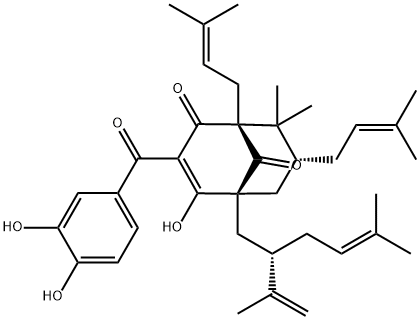Description
Garcinol (78824-30-3) is a HAT (histone acetyltransferase) inhibitor (p300 IC50=7 μM and PCAF IC50=5 μM) both in vitro and in vivo.1 It potentiates TRAIL-induced apoptosis of cancer cells. In cancer cells garcinol, independent of the cell type, induces both of the TRAIL receptors, death receptor 4 (DR4) and DR5. Garcinol neither induces the receptors of normal cells nor sensitizes them to TRAIL.2
Uses
Garcinol is an inhibitor of the histone acetyltransferases (HATs) p300 and PCAF (IC50 = 7 and 5 μM, respectively). It also inhibits the HAT GCN5 in Cryptococcus neoformans, inducing temperature sensitivity and impairing growth. A polyisoprenylated benzophenone isolated from Garcinia indica, garcinol promotes neurogenesis and ex vivo expansion of human hematopoietic stem cells. Moreover, it induces apoptosis in several types of cancer cells and has anti-inflammatory actions.
Uses
Garcinol is a small molecule inhibitor of histone acetyltransferases. Used in cancer therapy. Garcinol, harvested from Garcinia indica.
Definition
ChEBI: Garcinol is a monoterpenoid.
References
1) Balasubramanyam, et al.; (2004) Polyisoprenylated benzophenone, garcinol, a natural histone acetyltransferase inhibitor, represses chromatin transcription and alters global gene expression; J. Biol. Chem. 279 33716
2) Prasad, et al. (2010) Garcinol potentiates TRAIL-induced apoptosis through modulation of death receptors and antiapoptotic proteins; Mol. Cancer Ther. 9 856



